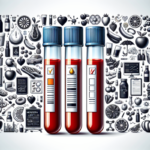In-Depth Exploration of Blood Test Units for Enhanced Health Awareness
A thorough understanding of your health starts with a clear comprehension of blood test units. These units form the essential communication tool used by healthcare professionals to relay vital information about how your body is functioning. Every test result, expressed in precise units, indicates the concentration of various substances present in your blood, making this quantification critical for accurate diagnoses, effective treatments, and comprehensive health management.
Understanding the Basics of Blood Test Units

To truly appreciate the importance of blood test units, it is essential to grasp how they are represented. Blood tests primarily measure quantities, assessing levels of critical components such as glucose, cholesterol, and electrolytes. The specific units may vary based on what is being measured, and they are crucial in determining whether a specific level falls within a healthy range or indicates potential health issues.
Blood test units can broadly be divided into two categories: those measuring concentration (for instance, grams per litre or millimoles per litre) and those indicating mass (like milligrams per decilitre). For example, while glucose levels are typically reported in milligrams per deciliter (mg/dL) in the United States, many other nations express them in millimoles per litre (mmol/L). Recognizing these differences is vital, as they can significantly affect the interpretation of test results.
Furthermore, these units facilitate standardization in health assessments across diverse populations. By adhering to established units, healthcare providers can ensure that results are communicated reliably and consistently, ultimately enhancing patient care and understanding.
Commonly Used Blood Test Units in Medical Practice
Among the extensive array of blood test units, certain units are more frequently encountered in medical practice. The most commonly used include:
– Millimoles per litre (mmol/L): This unit is widely employed for measuring glucose and cholesterol, especially in countries that utilize the metric system.
– Milligrams per decilitre (mg/dL): This unit is predominantly used in the United States for glucose and cholesterol evaluations. Recognizing the differences between these two units is essential for accurate health assessments.
International Units (IU): This unit is commonly used for vitamins and hormones, measuring a substance’s biological effect rather than its mass.
Each of these units carries its unique importance within the tests conducted. For instance, a glucose level of 5.6 mmol/L indicates normal blood sugar levels, but the equivalent reading at 100 mg/dL could lead to different interpretations if unit conversions are not properly understood.
Essential Skills for Converting Blood Test Units
Being able to convert between various blood test units is vital knowledge for both patients and healthcare professionals. Mastering these conversions can offer significant clarity when interpreting test results.
To convert glucose levels from mmol/L to mg/dL, one typically multiplies the value by 18. Conversely, to convert from mg/dL to mmol/L, one divides by 18. For example, a glucose reading of 6 mmol/L translates to approximately 108 mg/dL. This knowledge empowers patients to take a more active role in managing their health.
Numerous online calculators and conversion charts are readily available, making it easier for individuals to perform these conversions. Familiarizing oneself with these resources can enhance discussions with healthcare professionals, resulting in more informed and productive conversations regarding health.
Key Takeaways for Understanding Blood Test Units

Understanding the concept of blood test units is crucial for interpreting numerical data and gaining significant insights into one’s health. These units play a pivotal role in diagnosing various health conditions and in the accurate interpretation of results.
The Critical Role of Units in Diagnosing Health Conditions
The diagnostic process relies heavily on accurately measuring substances present in the blood. Each blood test unit serves as an essential tool that aids healthcare professionals in assessing health conditions. For example, elevated levels of cholesterol, expressed in mg/dL, may indicate an increased risk of heart disease, while abnormal glucose levels could suggest the presence of diabetes.
Healthcare providers utilize these units to establish reference ranges that define what is considered ‘normal’ for individuals in good health. When test results fall outside these ranges, it can signal underlying health issues that require further investigation. Therefore, understanding the units is imperative; they reflect an individual’s current health status and guide necessary interventions.
Moreover, a comprehensive understanding of these units facilitates early detection of diseases, potentially leading to more effective treatment outcomes. Therefore, patients are encouraged to become familiar with the relevant units related to their health assessments and the interpretation of blood test results.
Interpreting blood test units requires a nuanced approach. Each test result should be viewed in the context of the individual’s health history, symptoms, and other relevant factors. For example, a slightly elevated liver enzyme level might not be concerning on its own; however, if combined with additional symptoms, it could indicate a more serious condition that requires attention.
Additionally, factors such as age, gender, and lifestyle choices can significantly influence what is deemed normal. Healthcare providers often take these variables into consideration when discussing results with patients, providing a comprehensive view of health rather than merely presenting numbers.
Patients should feel empowered to ask questions about their results. Understanding what each unit signifies and how it relates to overall health enables individuals to take an active role in effectively managing their health.
Current Trends in Blood Test Units

The realm of blood test units is continuously advancing, with new trends emerging in standardization and technological enhancements. Recently, there has been a concerted effort to adopt more universally accepted units to reduce confusion, especially in globally-operating healthcare environments.
Moreover, advancements in technology have led to more sophisticated testing methods, resulting in increasingly accurate and dependable measurements. For instance, the rise of point-of-care testing devices allows for immediate feedback on blood test results, enabling quicker decision-making in clinical settings.
These trends not only enhance the quality of patient care but also promote a better understanding of health metrics among patients. As the healthcare landscape evolves, it is crucial for both patients and practitioners to stay informed about these changes.
Practical Applications of Blood Test Units for Everyday Health Management
Understanding blood test units extends beyond theoretical knowledge, carrying practical implications for daily health monitoring and management.
Leveraging Blood Test Units for Ongoing Health Monitoring
Individuals can utilize blood test units for continuous health tracking. Regular testing can provide valuable insights into one’s health status, enabling proactive management of conditions and lifestyle changes. For example, monitoring blood glucose levels can be particularly beneficial for those at risk of developing diabetes.
Home testing kits are increasingly accessible, allowing individuals to conveniently check their levels. By understanding the units connected with these tests, users can accurately interpret their results, enabling them to make necessary dietary or medication adjustments based on their readings.
Moreover, maintaining a health log that tracks these units over time can reveal important trends, helping users identify potential health issues before they escalate. This proactive engagement empowers individuals and enhances communication with healthcare providers, leading to more personalized health strategies.
Blood Test Units: Informing Fitness and Nutrition Choices
Blood test units provide critical information for fitness enthusiasts and those focused on nutrition, which can inform dietary adjustments and training schedules. For instance, athletes often monitor their electrolyte levels, which can fluctuate significantly during intense training sessions.
Understanding these units is key to optimizing performance. For example, runners may track their sodium levels to prevent dehydration and ensure peak performance during races. Similarly, monitoring blood sugar levels can guide meal timing and composition, enhancing energy levels and recovery.
Nutritionists and trainers frequently leverage these metrics to develop customized fitness plans that align with an individual’s unique requirements. By integrating blood test units into their fitness and nutrition strategies, individuals can achieve their health goals more effectively.
Blood Test Units: Essential for Chronic Disease Management
Blood test units are indispensable tools for individuals managing chronic conditions such as diabetes or heart disease. Regularly monitoring key metrics facilitates timely interventions and adjustments to treatment plans. For example, diabetic patients must consistently check their blood glucose levels to ensure they remain within targeted ranges.
Understanding the implications of units in these contexts empowers patients to take charge of their health management. By recognizing when values are too high or too low, individuals can make informed decisions regarding necessary medication changes or dietary modifications.
Healthcare providers can utilize this data to tailor treatments, leading to improved patient outcomes. This proactive approach to health management underscores the importance of familiarizing oneself with test units to comprehend health results effectively.
Addressing Frequently Asked Questions About Blood Test Units
As conversations surrounding blood test units continue, several questions arise that require clarification to enhance understanding.
What Do Various Blood Test Units Represent?
Different blood test units correspond to specific substances measured in the blood. For instance, glucose levels are often measured in mg/dL or mmol/L, whereas cholesterol is typically reported in mg/dL. Understanding these units enables an accurate interpretation of health status.
How Can I Accurately Read Blood Test Results?
Reading blood test units accurately requires knowledge of the reference ranges associated with each test. These ranges indicate what is considered normal. Patients should also take their unique health factors into account, as individual circumstances can impact these interpretations.
Do Blood Test Units Differ by Country?
Indeed, blood test units can vary significantly between countries. For example, while glucose levels are typically reported in mg/dL in the United States, many other nations prefer using mmol/L. This discrepancy highlights the importance of understanding the relevant units applicable in your specific region.
Advanced Concepts in Blood Test Units
Diving deeper into blood test units reveals a wealth of scientific principles and future possibilities.
The Scientific Foundations of Blood Test Units
Understanding the scientific basis of blood test units involves examining the biochemical processes that dictate how substances are quantified in the blood. Each unit reflects specific molecular weights and concentrations, which are critical for accurate testing and diagnosis.
Moreover, advancements in testing methodologies often stem from rigorous scientific research, ensuring that results are precise and applicable in clinical settings. This scientific foundation is vital for the ongoing enhancement of testing protocols.
Laboratory Standards Governing Blood Test Units
Laboratory standards are critical for ensuring the accuracy of blood test units. Regulatory agencies establish guidelines that laboratories must adhere to, ensuring that tests are consistently performed and results are reliable. These standards help mitigate variations that could lead to misdiagnosis or inappropriate treatments.
Additionally, technological advancements have encouraged laboratories to adopt more sophisticated methodologies, improving the precision of test results. Therefore, remaining informed about these standards is essential for both healthcare professionals and patients.
Future Innovations in Blood Test Units
Looking ahead, exciting advancements in blood test units can be anticipated. Innovations in technology, such as the integration of artificial intelligence in diagnostic processes, could lead to more personalized and accurate testing. Furthermore, standardizing units across countries may simplify processes for individuals who travel or live abroad.
As research continues to progress, the future of blood testing promises enhanced health outcomes and more accessible healthcare for everyone.
Real-World Applications of Blood Test Units: Case Studies and Examples
Practical applications of blood test units can provide valuable insights into their significance and usage.
Case Study: Successful Management of Blood Sugar Levels
In a recent case study, a patient with type 2 diabetes demonstrated how a solid understanding of blood test units aids in managing blood sugar levels. By closely tracking their glucose levels in both mg/dL and mmol/L, the patient learned to identify patterns related to diet and physical activity, leading to more effective management of their condition.
By consistently monitoring these values and discussing them with their healthcare provider, the patient made informed choices that resulted in better health outcomes. This case underscores the importance of clarity in understanding blood test units for successful chronic disease management.
Real-Life Example: The Impact of Blood Test Units During Pregnancy
Pregnant individuals frequently undergo a series of blood tests to monitor their health and that of their baby. A thorough understanding of blood test units is particularly crucial during this period, especially for tests assessing iron levels, glucose, and hormone levels.
For instance, a pregnant woman might be advised to maintain a specific hemoglobin level expressed in g/dL. Awareness of these units enables her to engage more effectively with her healthcare provider and make necessary lifestyle changes to support her and her growing baby’s health.
Case Study: Optimizing Athletic Performance through Blood Test Units
Athletes frequently leverage the knowledge of blood test units to enhance their performance. A case study involving a professional cyclist highlighted the significance of monitoring lactate levels, typically represented in mmol/L. By understanding their lactate threshold, the athlete could customize their training regimen to optimize endurance and performance.
This case exemplifies how a solid grasp of blood test units can greatly benefit athletic performance, enabling athletes to make data-driven decisions regarding their training and recovery strategies.
Resources for Deepening Your Understanding of Blood Test Units
Several resources are available for those interested in expanding their knowledge of blood test units.
Recommended Reading Materials on Blood Test Units
There are numerous publications that provide comprehensive insights into blood test units. Notable titles such as “The Art of Blood Testing” and “Understanding Blood Tests: A Patient’s Guide” offer valuable information on interpreting test results and their health implications.
Online Platforms Offering Information on Blood Test Units
A variety of websites and tools are available to assist individuals in understanding blood test units. Platforms like Lab Tests Online and the Mayo Clinic provide easily accessible information on various blood tests, clarifying their meanings and offering guidance on how to interpret results effectively.
Educational Programs and Workshops on Blood Test Units
For individuals seeking deeper learning opportunities, numerous courses and workshops focus on blood test units. Many healthcare institutions offer training programs that cover the science of blood testing, result interpretation, and the latest advancements in laboratory standards.
Frequently Asked Questions Regarding Blood Test Units
What Are Blood Test Units?
Blood test units are standardized measurements that quantify various components in the blood, offering crucial information for diagnosing health conditions.
Why Are Different Units Used?
Different units standardize measurements for specific substances, ensuring consistency and accuracy in health assessments across various regions and laboratories.
How Do I Convert Blood Test Units?
You can convert between blood test units through multiplication or division. For instance, to convert glucose levels from mmol/L to mg/dL, multiply by 18.
Why Is Understanding Blood Test Units Important?
Familiarity with blood test units is essential for accurately interpreting health data, facilitating timely diagnoses, and guiding treatment decisions.
Can Blood Test Units Change Over Time?
Yes, blood test units may change with advancements in medical standards, technology, and practices within the healthcare sector.
Are Home Blood Tests Reliable?
Home blood tests can be reliable; however, it is crucial to carefully follow the manufacturer’s guidelines and consult healthcare professionals for interpreting results.
What Is the Role of Healthcare Providers in Blood Testing?
Healthcare providers play a crucial role in ordering tests, interpreting results, and advising patients on necessary lifestyle changes based on findings.
How Often Should I Undergo Blood Tests?
The frequency of blood tests depends on individual health conditions, risk factors, and recommendations from healthcare professionals.
What Steps Should I Take If My Blood Test Results Are Abnormal?
If your blood test results are abnormal, consult your healthcare provider for evaluation and recommendations regarding treatment or further testing.
Where Can I Find More Information About Blood Test Units?
You can expand your understanding of blood test units through literature, online resources, and educational courses focused on health and laboratory testing.



Your exploration of blood test units provides a vital framework for understanding health information that often feels overwhelming to many of us. Personally, I’ve found that becoming familiar with these units has been instrumental in navigating my own health journey. For example, when I first received my lipid panel results, I was taken aback by the various units like mg/dL for cholesterol and mmol/L for triglycerides, which were completely foreign to me at the time.